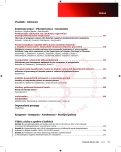-
Medical journals
- Career
Phlebotomy and therapeutic apheresis in the treatment of polyglobulia
Authors: M. Bohoněk; J. Hrabánek; M. Kořánová; D. Kutáč
Authors‘ workplace: Oddělení hematologie a krevní transfuze, Ústřední vojenská nemocnice – Vojenská fakultní nemocnice Praha
Published in: Transfuze Hematol. dnes,19, 2013, No. 4, p. 216-222.
Category: Comprehensive Reports, Original Papers, Case Reports
Overview
The efficiency and suitability of two cyto-reduction methods in the treatment of polyglobulia – phlebotomy and double erythrocytapheresis – were evaluated by retrospective analysis. This study evaluated the treatment of 44 patients (33 male, 11 female) in the years from 2001 to 2013. Total number of procedures was 364, number of double erythrocytapheresis was 284 (median age 64.4 years), number of phlebotomies series was 80 with an average of 2.13 phlebotomies per series (median age 69 years). The most frequent diagnosis was polycythaemia vera (n = 26), followed by secondary polycythaemia (n = 17) and 1 patient had familiar erythrocytosis. Treatment in polycythaemia vera and familiar polycythaemia was indicated at Ht > 0.50, with a therapeutic goal of Ht < 0.45. Treatment in secondary polycythaemia was indicated at Ht > 0.55, achieved Ht value should not drop below 0.50 or 0.55, respectively. In most cases, the treatment of choice consisted of double erythrocytapheresis using Haemonetics MCS+, while phlebotomy was indicated mainly with patients with poor venous access or with poor toleration of apheresis. Median of collected blood during a single series of phlebotomy was 914.6 ml. Median of initial Ht was 0.54, final Ht 0.50 and decrease of Ht 0.048. With median frequency 112 days, median number of phlebotomies was 7 per year. In double erythrocytapheresis, median collected RBCs was 415 ml. Median initial Ht was 0.54, final Ht 0.47 and decrease of Ht 0.07. Median frequency was 98 days, median procedures was 3.7 per year. Double erythrocytapheresis is sufficient to achieve the Ht target values in most patients with polycythaemia vera as well as secondary polycythaemia. For a majority of patients, the method is more comfortable than phlebotomy, brings faster relief and decreases the number of hospital visits. Double erythrocytapheresis has been shown to be a suitable cyto-reduction method that rapidly and safely corrects increased haematocrit values at an acceptable cost.
Key words:
polyglobulia, phlebotomy, therapeutic apheresis, double apheresis
Sources
1. McMullin MF, et al. Guidelines for the diagnosis, investigation and management of polycythaemia vera / erythrocytosis. British Journal of Hematology 2005; 130 : 174-190.
2. Indrák K, Alušík Š. Hematologie. 1. vyd. Praha, Triton, 2006; Vnitřní lékařství, sv. 7 : 75-81, 149-153.
3. Dítě P. Vnitřní lékařství. 2. doplněné a přepracované vyd. Praha, Galén, 2007; 187-188, 224 - 226.
4. Adam Z, Krejčí M. Hematologie: přehled maligních hematologických nemocí. 2. doplněné a zcela přepracované vyd. Praha, Grada, 2008; 57-64.
5. Češka R, et al. Interna. 1. vyd. Praha, Triton, 2010; 675, 682-683.
6. Kučerová J, Horváthová M, Pospíšilová D, Divoký V. Vrozené polycytemie. Transfuze hematol dnes 2009; 4 : 216-222.
7. Kissová J, Penka M. Myeloproliferativní neoplazie a myelodysplasticko / myeloproliferativní neoplazie. In: Penka M, Slavíčková E. Hematologie a transfuzní lékařství. 1. vyd. Praha, Grada, 2011; 327-328.
8. Passamonti F. How to manage polycythemia vera. Leukemia 2011; 26 : 870-874.
9. Schwarz M, Penka M, Campr V, et al. Diagnostika a léčba BCR/ABL-negativních myeloproliferativních onemocnění – principy a východiska doporučení CZEMP. Vnitř Lék 2011; 57(2): 189-213.
10. Pepkowitz S. Red Cell Exchange and Other Therapeutic Alterations of Red Cell Mass. In: McLeod BC, Price TH, Drew MJ, eds. Apheresis: Principles and Practice. Bethesda, MD: AABB Press, 1997; 366.
11. Szczepiorkowski ZM, et al. Guidelines on the Use of Therapeutic Apheresis in Clinical Practice - Evidence-Based Approach from the Apheresis Applications Committee of the American Society for Apheresis. Journal of Clinical Apheresis 2010; 25 : 83–177.
12. Pollari G, Antonini V, Izzo A, et al. The role of erythrocytapheresis in secondary erythrocytosis therapy. Clinical Hemorheology and Microcirculation 1999; 21 : 353-355.
13. Vecchio S, Leonardo P, Musaraca V, D´Ettoris AR, Geramicca W. A comparison of the results obtained with traditional phlebotomy and with therapeutic erytrocytapheresis in patients with erythrocytosis. Blood transfusion 2007; 5 : 20-23.
14. Turek P., Řeháček V. Výroba transfuzních přípravků. Gašová Z. Terapeutické aferézy. In: Řeháček V, et al. Transfuzní lékařství. 1. vyd. Praha, Grada, 2013; 119-120.
15. Kaboth U, Rumor KW, Liersch T, Vehmeyer K, Krieter D, Kaboth W. Advantages of isovolemic large-volume erythrocytapheresis as a rapidly affective and long-lasting treatment modality for red blood cell depletion in patients with polycythemia vera. Therapeutic Apheresis: Official Journal Of The International Society For Apheresis And The Japanese Society For Apheresis 1997; 1 : 131-4.
16. Procházková R. Multikomponentní aferetické odběry krve. 1. vyd. Brno, Tribun EU, 2009; 16.
Labels
Haematology Internal medicine Clinical oncology
Article was published inTransfusion and Haematology Today

2013 Issue 4-
All articles in this issue
- The issue of pregnant women with BCR/ABL negative myeloproliferative neoplasms
- Malignant tumours in adult patients after successful treatment of acute myeloid leukemia: long-term experience at the Department of Hemato-Oncology in Olomouc
- Phlebotomy and therapeutic apheresis in the treatment of polyglobulia
- Influence of processing of platelet lysate at selected of platelets factors
- Stability of coagulation factors in thawed plasma
- Blood cell storage lesion
- Antithrombin
- Transfusion and Haematology Today
- Journal archive
- Current issue
- Online only
- About the journal
Most read in this issue- Phlebotomy and therapeutic apheresis in the treatment of polyglobulia
- Antithrombin
- Stability of coagulation factors in thawed plasma
- Blood cell storage lesion
Login#ADS_BOTTOM_SCRIPTS#Forgotten passwordEnter the email address that you registered with. We will send you instructions on how to set a new password.
- Career

